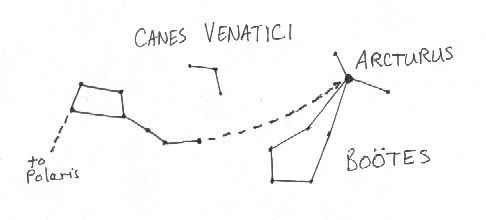Or perhaps a different goddess, Ceres, campaigned to give a herdsman a place in the sky as a reward for inventing the plow.
On the other hand, maybe a grape grower treated his buddies to a fresh batch of wine made from Bacchus's own top-secret recipe. When the friends woke up with one of those "I wish I were dead" hangovers, they somewhat illogically assumed that they felt lousy because their pal had intentionally poisoned them, so naturally they killed him. And - get out your handkerchiefs - his faithful dogs then died in grief over the loss of their master.
These are some of the stories associated with the constellation Bootes, the Herdsman (also known as the Plowman.) Bootes (pronounced bo-OH-teez) presents a couple of problems for a backyard astronomer. Most of the stars are rather dim and difficult to see from city locations. As the stars are usually connected in constellation drawings, they bear absolutely no resemblance to a herdsman. They look more like a kite, or a club, or a wine flask. And with both the Great Bear and the Hunting Dogs nearby in the sky, it's tough to figure out which story about the constellation's origin is the real one.
 What Bootes can offer the urban astronomer, though, is the fourth-brightest star in the sky, Arcturus. Arcturus is usually the first star visible at dusk in late spring, and is easy to find using the Big Dipper as a pointer. The handle of the Big Dipper forms a curve. Continue to follow that curve for 30 degrees (three fist widths) from the end of the Dipper's handle, and you will come to Arcturus in the eastern sky. Not only is it easy to find, it is easy to remember: Follow the Arc to Arcturus.
What Bootes can offer the urban astronomer, though, is the fourth-brightest star in the sky, Arcturus. Arcturus is usually the first star visible at dusk in late spring, and is easy to find using the Big Dipper as a pointer. The handle of the Big Dipper forms a curve. Continue to follow that curve for 30 degrees (three fist widths) from the end of the Dipper's handle, and you will come to Arcturus in the eastern sky. Not only is it easy to find, it is easy to remember: Follow the Arc to Arcturus.Arcturus gained a bit of fame in the US during the Chicago World's Fair in 1933. The fair was opened when the light from Arcturus triggered a photoelectric cell. Chicago had previously hosted a world's fair in 1893, and the star was believed to be 40 light years from earth. That meant that the light which opened the 1933 fair had left Arcturus during the 1893 fair. It was a charming idea, but it turns out that Arcturus is only 36 or 37 light years away. The 1893 light had come and gone by the time of the second fair.
If your location is dark enough that you can see all of the stars of Bootes, try looking for tiny, faint Canes Venatici, the Hunting Dogs. Only two of the stars are clearly visible to the naked eye. They are between the bowl of the Big Dipper and Arcturus.

The Piker Press moderates all comments.
Click here for the commenting policy.